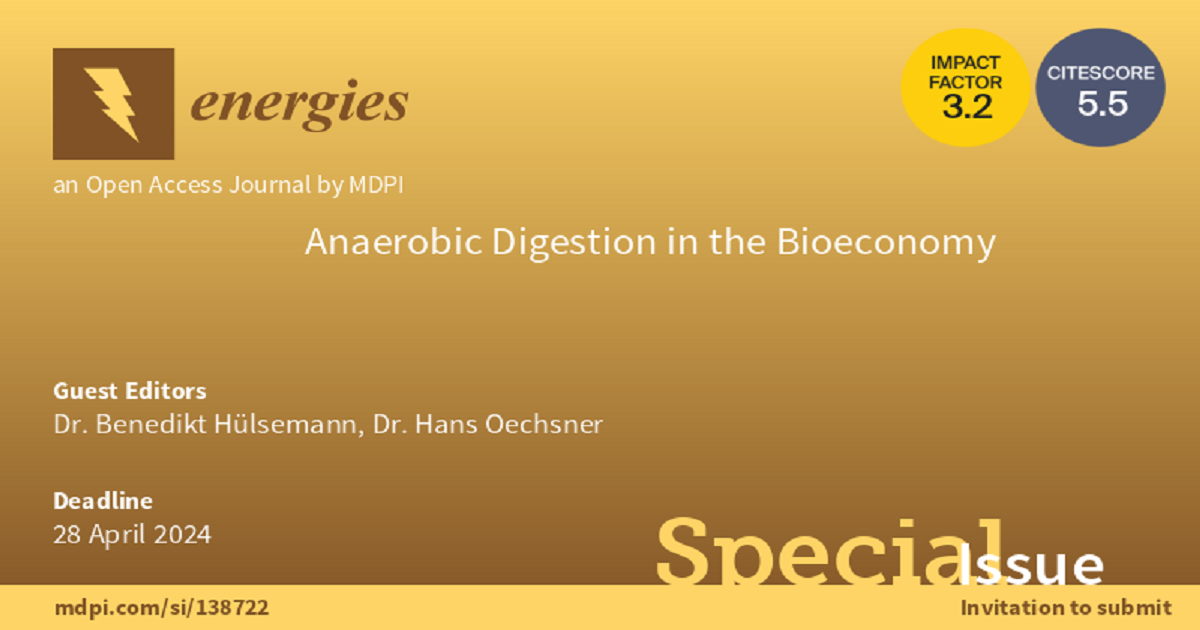Anaerobic Digestion in the Bioeconomy
A special issue of Energies (ISSN 1996-1073). This special issue belongs to the section "A4: Bio-Energy".
Deadline for manuscript submissions: closed (28 April 2024) | Viewed by 9214

Special Issue Editors
Interests: biogas; biomethane; pretreatment; bioeconomy; steam explosion; waste; residuals; fibers; anaerobic digestion
Special Issues, Collections and Topics in MDPI journals
Interests: bioenergy; biogas process; trace elements for biogas; pretreatment of substrates; drying of digestate; efficiency of biogas processes; BMP test methods; energy crops; AD of organic waste; platform chemicals
Special Issues, Collections and Topics in MDPI journals
Special Issue Information
Dear Colleagues,
Due to various crises, material and energy costs are rising worldwide, while at the same time global warming continues to advance. For these reasons, the efficient use of regionally available materials is increasingly in the focus of public interest. Anaerobic digestion, e.g., in the form of biogas plants, can help to use organic residues as efficiently as possible in bioeconomy concepts.
Thereby, various organic residual materials accumulate in agriculture, as well as in industry or in the municipality as biowaste, which are often only composted or even combusted today. The use of these materials in anaerobic digestion or within a bioeconomy concept can significantly increase the economic efficiency of anaerobic digestion and resource efficiency and can also reduce the rate of CO2 emission significantly. The products of such bioeconomy concepts are very broadly diversified. Thus, both the energetic use in the form of biogas (electricity, heat or fuel) and the material utilization in the form of fibers, bioplastics, or platform chemicals are conceivable. In the same way, the implementation of possible optimization ranges from targeted substrate preparation to optimization of the process conditions of anaerobic digestion to complete ecological and economic evaluation of entire bioeconomic models.
This Special Issue welcomes the submission of articles that deal with the mentioned topic both theoretically in modeling and practically in the form of laboratory or full-scale trials.
The products of such bioeconomy concepts are very broadly diversified. Thus, both the energetic use in the form of biogas (electricity, heat or fuel) and the material utilization in the form of fibers, bioplastics, or platform chemicals are conceivable. Topics of interest for publication include, but are not limited to:
- Potential analysis of residual materials
- Pre-treatment of the substrate
- New concepts of anaerobic digestion
- Design of anaerobic digestion
- Process condition of anaerobic digestion
- Ecological evaluation
- Economic evaluation
- New bioeconomic concepts including anaerobic digestion
- Treatment and use of digestate
- Evaluation of products of the bioeconomic model
- Modelling of the processes
Dr. Benedikt Hülsemann
Dr. Hans Oechsner
Guest Editors
Manuscript Submission Information
Manuscripts should be submitted online at www.mdpi.com by registering and logging in to this website. Once you are registered, click here to go to the submission form. Manuscripts can be submitted until the deadline. All submissions that pass pre-check are peer-reviewed. Accepted papers will be published continuously in the journal (as soon as accepted) and will be listed together on the special issue website. Research articles, review articles as well as short communications are invited. For planned papers, a title and short abstract (about 100 words) can be sent to the Editorial Office for announcement on this website.
Submitted manuscripts should not have been published previously, nor be under consideration for publication elsewhere (except conference proceedings papers). All manuscripts are thoroughly refereed through a single-blind peer-review process. A guide for authors and other relevant information for submission of manuscripts is available on the Instructions for Authors page. Energies is an international peer-reviewed open access semimonthly journal published by MDPI.
Please visit the Instructions for Authors page before submitting a manuscript. The Article Processing Charge (APC) for publication in this open access journal is 2600 CHF (Swiss Francs). Submitted papers should be well formatted and use good English. Authors may use MDPI's English editing service prior to publication or during author revisions.
Keywords
- biogas production
- bioeconomic
- agricultural waste
- industrial waste
- anaerobic digestion
- fibre production
- platform chemicals
- efficiency
- renewable energy
Benefits of Publishing in a Special Issue
- Ease of navigation: Grouping papers by topic helps scholars navigate broad scope journals more efficiently.
- Greater discoverability: Special Issues support the reach and impact of scientific research. Articles in Special Issues are more discoverable and cited more frequently.
- Expansion of research network: Special Issues facilitate connections among authors, fostering scientific collaborations.
- External promotion: Articles in Special Issues are often promoted through the journal's social media, increasing their visibility.
- Reprint: MDPI Books provides the opportunity to republish successful Special Issues in book format, both online and in print.
Further information on MDPI's Special Issue policies can be found here.






